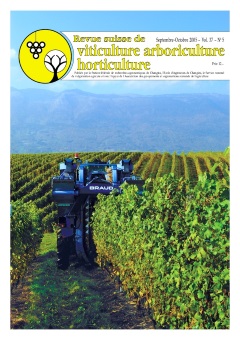
Issue 5 - September - October 2005
Abstract in open access
The inter-specific grape cultivars Cabernet Cortis, Cabernet Carol, Cabernet Carbon, Prior and Monarch, created by the Research institute for viticulture in Freiburg im Breisgau (D), have been tested since 1999 on the experimental vineyard of Agroscope RAC Changins at Pully (Lake of Geneva region, Switzerland). The five cultivars have shown a high resistance against downy mildew. On the other hand, their sensitivity to powdery mildew is as high or higher than that of the reference Vitis vinifera cv. Pinot noir, particularly for the cultivar Cabernet Cortis. Depending on the disease pressure, the use of fungicides can be necessary to produce healthy grapes. Cabernet Carol is highly sensitive to powdery mildew, botrytis bunch rot and bunch stem necrosis, and therefore could not be used to make wine.
Cabernet Cortis, ripening relatively early, and Cabernet Carbon, ripening late, produce colourful and tannic wines with vegetal characters. Prior and Monarch, ripening slightly later than Pinot noir, also produce polyphenol-rich wines with an interesting fruity character. Globally, Prior shows the best overall qualities.
Key words: inter-specific grape varieties, Cabernet Cortis, Cabernet Carol, Cabernet Carbon, Prior, Monarch, wine.
Keywords:
E-Mail: jean-philippe.mayor@acw.admin.ch
Adress: Agroscope, 1009 Pully
Abstract in open access
There is a growing diversity of strategies to control grapevine moth Lobesia botrana and grape berry moth Eupoecilia ambiguella, the two dominant pest species in the vineyards of Central Europe. This article reviews the various methods based on the use of sexual pheromones, which were used in the past, are currently in use or still in development: mass trapping, attract-and-kill, autosterilization, mating disruption (conventional, false-trail following, micro-encapsulated formulations, auto-confusion). The theoretical mode of action and strengths and weaknesses of each technique are discussed. Finally, a general assessment of the various procedures is presented according to different criteria (efficacy, costs, work, etc.).
Key words: Lobesia botrana, Eupoecilia ambiguella, mass trapping, attract-and-kill, autosterilization, mating disruption, false-trail following, microcapsules, autoconfusion.
Keywords:
E-Mail: serge.fischer@agroscope.admin.ch
Adress: Agroscope, 1260 Changins/Nyon
Abstract in open access
Three new type of dispensers for mating disruption of grapevine moth Lobesia botrana and grape berry moth Eupoecilia ambiguella were tested: small Ecodian dispensers as well as Isonet-L Plus and Isonet-E Plus dispensers. Microcapsules were sprayed by means of the classical treatment devices. The attract-and-kill method with pastes containing pheromones and an insecticide and the autoconfusion technique were also evaluated. Each of these procedures has been tested in two vineyards on a total surface ranging from 8.6 to 13.7 ha, except for autoconfusion, which was applied in a single vineyard on 4.6 ha.
The captures of male moths in pheromone traps were strongly inhibited or completely suppressed with all treatments except for autoconfusion. Concerning infestation rates, Ecodian and Isonet-L Plus dispensers as well as the microcapsules showed an effectiveness similar to that of classical insecticide treatments or already registered dispensers. The effectiveness of the Isonet-E Plus dispensers and of the attract-and-kill technique was lower than that of classical control. Autoconfusion, tested in a sector with higher pest pressure, had practically no effect. Of course, these preliminary results have to be confirmed in situations with higher population densities than those observed in 2004.
Key words: grape berry moth, Eupoecilia ambiguella, grapevine moth, Lobesia botrana, mating disruption, microcapsules, attract & kill, autoconfusion.
Keywords:
E-Mail: pierre-joseph.charmillot@acw.admin.ch
Adress:
Abstract in open access
The cold storage of Mairac® apples was tested from 2002 to 2004. The objective was to compare the cold storage in controlled atmosphere CA and ULO (Ultra Low Oxygen) and to determine the optimal harvest period.
The cold storage of Mairac® apples in ULO gave the best results. Quality parameters such as firmness and malic acid content of the fruits were better and the propagation and intensity of core browning was reduced. The cold storage of Mairac® apples in ULO conditions allows maintaining the quality and reducing the brown heart disease till the month of May.
Key words: storage, ULO, apples, controlled atmosphere, core browning, quality
Keywords:
E-Mail:
Adress: Agroscope, 1260 Changins/Nyon
Abstract in open access
Preference mapping techniques, widely used by the food industry, explain consumers appreciation of products according to their sensory properties. To test the profitability of these techniques forWest Switzerland viti- and viniculture, a study of the appreciation of Pinot noir wines by consumers of Frenchspeaking Switzerland was carried out by the Engineering School of Changins.
The results show that the preference mapping approach is quite suitable to wine. Statistical relation between the consumer’s taste and the sensory profile of six Pinot noir wines let appear four distinct preference groups. In the two major groups, mainly constituted by 30 to 41 years-old individuals, wines with opulent, concentrated and woody characteristics were preferred. Simpler, fruity and light wines were favoured in the two minor groups, where 18 to 29 years-old persons dominated.
Preference mapping appears as an innovative and discriminating tool that could be of great help for the Swiss vini-viticulture confronted with an increasingly competitive market.
Key words: preference mapping, Pinot noir, wine, Switzerland.
Keywords:
E-Mail: christian.guyot@eichangins.ch
Adress: Agroscope, 1260 Changins/Nyon

 Download of full issue
Download of full issue
 Download article
Download article